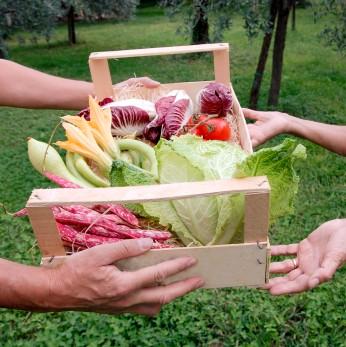
The search for ways to feed the hungry is as old as recorded history. Can an issue this long-standing and complex be adequately addressed on small, local level? A unique California program is trying, with surprising success.
Ag Against Hunger unites farmers, food processors and nonprofit food banks in the effort to reduce hunger and promote food security as it simultaneously benefits agriculture producers. This one-of-a-kind program is changing the way fresh fruits and vegetables move through the California food system. The goal is, of course, a secure source of healthful nutrition for all, and an improvement in the health of the more than 20% of our local population that is in need throughout our community.
How We Operate - Ag Against Hunger works with large and small farmers, food processors, and distributors on behalf of food banks, to help the non-profits fully benefit from bountiful harvests. Currently up and running in Monterey, Santa Cruz and San Benito counties, the program has become an efficient model of ways to distribute perishable surplus produce.
When an influx of fresh fruits and vegetables exceeds a grower's or processor’s capacity, Ag Against Hunger picks up, refrigerates, stores and re-distributes the large quantities of newly available, highly perishable fruits and vegetables to rural and urban food banks. Being organized for a quick response is key.
The large-scale and perishable nature of the produce we collect far exceeds what a single food bank could store and distribute. Everyone involved benefits. Food bank clients receive fresh fruits and vegetables that would otherwise be destroyed. Food processors are able to donate their products, knowing that the goods will be handled quickly for optimal freshness and nutrition, and they do not incur the expense of disposing of perfectly good and healthful food into a landfill.
What We've Accomplished - Each year Ag Against Hunger swiftly moves an average of 10 million pounds of highly perishable food into food banks from fields or processing plants, using a coordinated system of refrigerated tractor-trailers and a 5,000 square foot storage cooler.
Since its inception in 1990, the organization has distributed over 154 million pounds of produce to people in need. Locally, Food Bank for Monterey County, Second Harvest of Santa Cruz and San Benito Counties, Grey Bears of Santa Cruz and Community Pantry of San Benito County make our fresh produce available to more than 260 nonprofit human service agencies, and feed over 75,000 low-income people each month.
Food and Health - Adequate and appropriate nutrition is a linchpin of well-being and health that's especially challenging with limited financial resources. The connection between chronic illnesses — diabetes is just one example — and diets poor in fruits and vegetables is well-established. The correlation is strong: The Department of Agriculture states that improved nutrition and lifestyle could reduce illness and death due to cancer by 30-40%, death from cardiovascular disease by 22-30%, and cases of diabetes by 50%.
Among children (who make up more than 1/4 of Ag Against Hunger recipients), diet patterns establish the foundation of adult eating habits. For seniors (27% of our recipients), and pregnant women, healthful eating is also critical.
The affluent enjoy the option of choosing among a range of nutritious foods and healthy lifestyles. For the poor, the only option is whatever is available and possible at the moment. This lack of healthful food choices contributes to the health disparities we see between the affluent and others, and the increasing number of low-income individuals with chronic health conditions that spring from poor nutrition.
Localism Can Stretch - Last year Ag Against Hunger was able to provide over 8.7 million pounds of high-quality fresh fruits and vegetables to over 50 rural and urban food banks throughout California and beyond. Once nearby local food banks were satisfied, it worked with California Emergency Foodlink, a statewide food distribution program, which dispersed produce to over 50 food banks and community pantries in other parts of the state. After state organizations received all the produce they needed, it worked with food organizations in Arizona, Washington, Oregon, Colorado, Utah and New Mexico to feed about three million people throughout the US West Coast states.
Ag Against Hunger also coordinates a thriving gleaning program. In 2008 volunteers harvested more than 120,000 pounds of produce that would have otherwise been disked underground. On a few weekends each month, 25 to 100 volunteers from diverse organizations — Cub Scouts to church groups — come together to harvest these crops, learn about their local agricultural community, and directly contribute to the amount of produce we pass along to our food bank partners.
If you are interested in becoming a gleaning volunteer or learning more, please give us a call at 831.755.1480, or visit Ag Against Hunger at www.agagainsthunger.org
Abby Taylor-Silva is the Executive Director of Ag Against Hunger, a Salinas-based non-profit. She is a native of Monterey and San Benito counties; her family farmed in south Monterey County for over 50 years. She lives in Salinas with her husband Paul and daughter Olivia.













great post
excellent. one of the best articles I have every read. This is the information which I have been searching. Great information. Ecopolitan EC | Ecopolitan EC price | Ecopolitan | Ecopolitan Punggol | Ecopolitan Executive Condo | Sea Horizon | Sea Horizon EC | Sea Horizon Executive Condo | Sea Horizon Executive Condominium | Sea Horizon Pasir Ris | Sea Horizon EC price | Tembusu Condo | Tembusu at Kovan | Tembusu Kovan | Tembusu condo Price | Tembusu | Vue 8 residence | Vue 8 residence price | Vue 8 Condo | Vue 8 Pasir Ris | Vue 8 | the inflora | inflora condo | inflora loyang | inflora this article is worth bookmarking. keep it up !